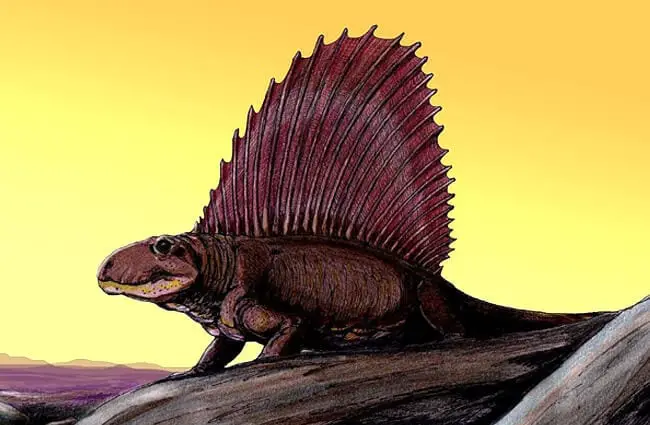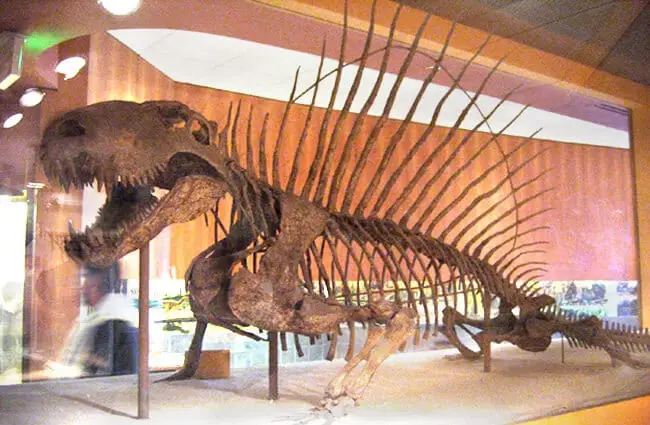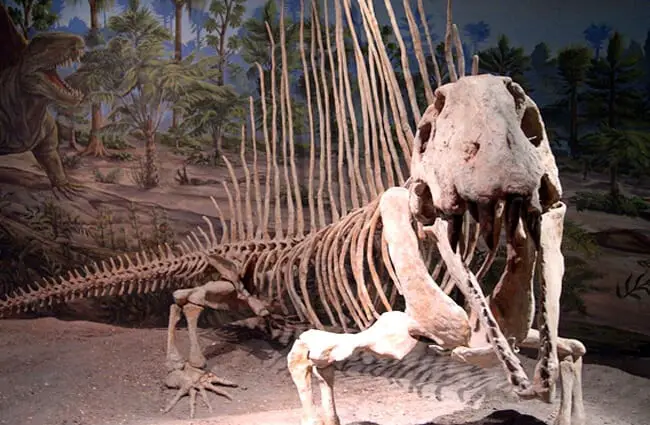The Permian Period, a time long before the dinosaurs, was dominated by a fascinating creature often mistaken for one. This is the story of Dimetrodon, a powerful apex predator with a truly iconic feature—the enormous sail on its back. While visually similar to dinosaurs, Dimetrodon wasn’t one at all. It belonged to a group of early amniotes called synapsids, representing a crucial step in the evolution of mammals.

What Was Dimetrodon?
Dimetrodon lived approximately 290 to 272 million years ago, during the late Permian period. It roamed what is now North America and Europe. Reaching lengths of 8 to 15 feet and weighing upwards of a ton, Dimetrodon was a formidable predator. It possessed a robust build, powerful limbs, and a skull filled with sharp, serrated teeth perfect for tearing flesh. However, it is the neural spine elongation and forming that spectacular sail that truly sets it apart.
Anatomy and the Iconic Sail
The sail wasn’t formed by bone, but by elongated neural spines, bony projections extending from the vertebrae. These spines were covered in skin and blood vessels. For decades, scientists debated the function of this remarkable feature. Initial theories suggested it served as a thermoregulatory device. The large surface area would allow Dimetrodon to absorb heat in the cool mornings and dissipate it in the warmer afternoons, acting like a solar panel. More recent research suggests the sail likely played a significant role in display—perhaps for attracting mates or intimidating rivals. It’s also plausible it served a combination of both functions.
Habitat and Distribution
Fossil evidence indicates Dimetrodon thrived in swampy, humid environments. These areas, characterized by lush vegetation and abundant waterways, would have provided ample hunting grounds for this predator. The fossil record shows a relatively wide distribution for Dimetrodon, with discoveries made across regions of North America, including areas that are now Texas, Oklahoma, and Europe. These regions during the Permian period likely formed a connected landmass called Pangaea, allowing for relatively easy movement between populations.

Diet and Hunting Strategies
As an apex predator, Dimetrodon sat at the top of the food chain. Its diet consisted primarily of other large amphibians and reptiles, including early herbivorous synapsids. The creature likely employed ambush tactics, using its powerful build to overpower prey. Fossil evidence of bite marks and healed injuries on other Permian creatures suggests Dimetrodon engaged in violent confrontations. Its teeth, while sharp, weren’t designed for shearing like those of mammals. Instead, they were ideal for gripping and tearing flesh. It would have swallowed chunks of meat, rather than meticulously chewing it.
Evolutionary History and Relationships
Dimetrodon is classified as a synapsid, a group of amniotes that eventually gave rise to mammals. This is a crucial distinction from dinosaurs, which are reptiles. Synapsids differ from reptiles in several key anatomical features, including the presence of a single temporal fenestra—an opening in the skull behind the eye socket. This feature is considered an important step in the evolution of the mammalian jaw and ear. Dimetrodon represents an early branch of the synapsid lineage, preceding the more mammal-like therapsids. Understanding its place in the evolutionary tree helps us trace the origins of mammals and their unique characteristics.

Reproduction and Life Cycle
While direct evidence is scarce, scientists believe Dimetrodon likely reproduced through internal fertilization and laid eggs. This is based on comparisons with other early amniotes. The size and structure of the hips suggest females could have carried a relatively small number of large eggs. The young likely received minimal parental care, relying on their instincts and developing quickly to avoid predation. Growth rates are difficult to determine, but it’s probable Dimetrodon reached maturity over several years.
Social Behavior
The extent to which Dimetrodon exhibited social behavior is unknown. It is possible they lived solitary lives, coming together only to mate. However, some fossil discoveries suggest the possibility of communal nesting sites. Further research is needed to understand their social dynamics.
Dimetrodon and its Ecosystem
Dimetrodon played a vital role as an apex predator in its Permian ecosystem. By controlling the populations of other large herbivores and reptiles, it helped maintain the balance of the environment. Its presence would have influenced the distribution and behavior of other species. Fossil evidence suggests Dimetrodon coexisted with a variety of other creatures, including early reptiles, amphibians, and plant life. The health of the ecosystem was likely dependent on the interactions between these different species.

Encountering a Dimetrodon (A Thought Experiment)
Of course, encountering a living Dimetrodon is impossible. However, if one were to miraculously appear today, it would be a supremely dangerous creature. Its powerful build, sharp teeth, and predatory instincts would make it a threat to humans and other large animals. It would likely be territorial and aggressive. The best course of action would be to maintain a safe distance and report the sighting to appropriate authorities.
Cultural Impact and Paleontological Significance
Dimetrodon, despite often being mistaken for a dinosaur, has captured the public’s imagination for generations. It features prominently in popular culture, appearing in books, films, and documentaries. It serves as a powerful reminder of the diversity of life that existed long before the dinosaurs. From a paleontological standpoint, Dimetrodon provides valuable insights into the evolution of amniotes and the origins of mammals. Studying its anatomy, behavior, and environment helps us understand the history of life on Earth.
Dimetrodon stands as a captivating creature from a distant past, a testament to the power of evolution and the fascinating story of life on Earth. Its iconic sail and predatory nature continue to intrigue and inspire, solidifying its place as a beloved figure in the world of paleontology.

![Red Angus Closeup of a beautiful Red Angus cowPhoto by: U.S. Department of Agriculture [pubic domain]https://creativecommons.org/licenses/by/2.0/](https://animals.net/wp-content/uploads/2020/03/Red-Angus-4-238x178.jpg)




![Red Angus Closeup of a beautiful Red Angus cowPhoto by: U.S. Department of Agriculture [pubic domain]https://creativecommons.org/licenses/by/2.0/](https://animals.net/wp-content/uploads/2020/03/Red-Angus-4-100x75.jpg)

